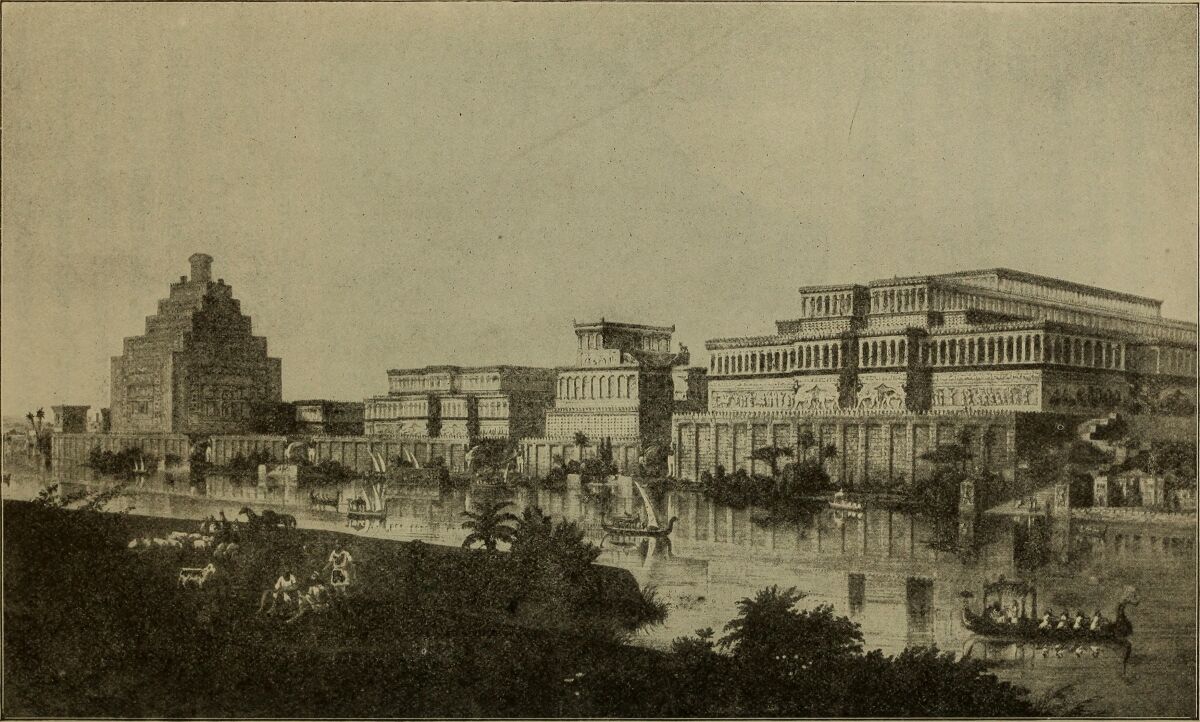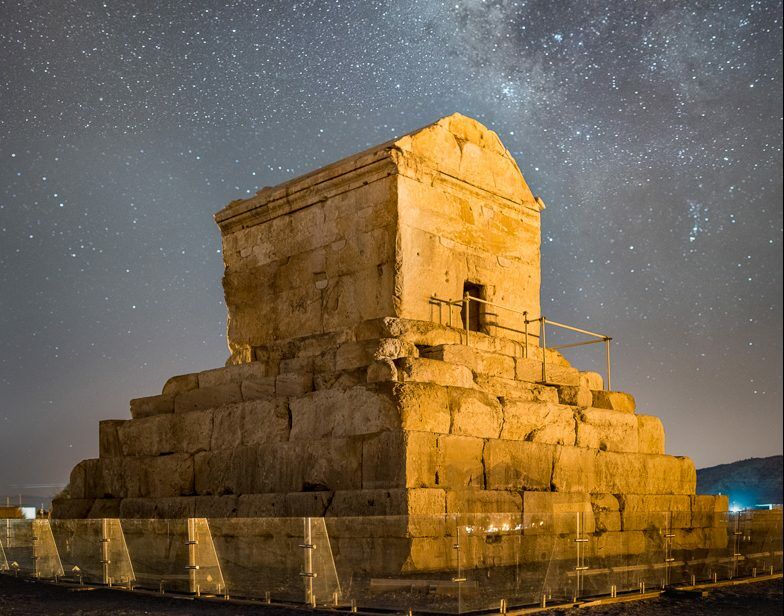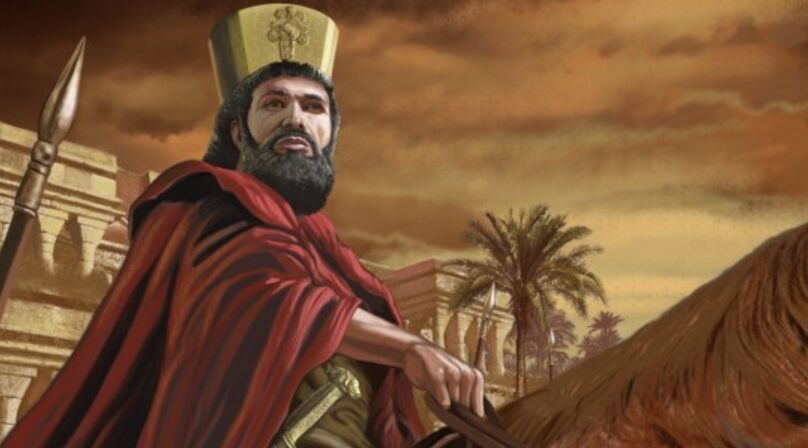Even today, more than 2,500 years after his death, Cyrus the Great of ancient Persia remains one of humanity’s most brilliant and outstanding monarchs. There is much to learn and admire about King Cyrus, and no dearth of knowledge on this subject.
But the most interesting feature about this man and his towering accomplishments is also the most obscure. It is also profoundly inspiring.
Who Was Cyrus?
Cyrus II ruled the Persian Empire from 559 to 530 b.c.e. The history of his life and accomplishments is well documented by Greek and Roman historians and by archaeological evidence. Among his many feats, Cyrus conquered the invincible Babylonian-Chaldean Empire and established Persia as the world power.
Under Cyrus, the borders of the Persian Empire rapidly expanded to create the largest empire humanity had ever seen. Under his leadership, ancient Persia’s borders stretched to Central Asia (Russia’s southern border today); as far east as the Indus River (the Pakistan-India border); as far north as the Danube, including Turkey, Crete and the southern parts of Greece and Bulgaria; and as far south as Libya.
But Cyrus was much more than a prodigious conqueror. He heralded a new breed of leadership and politics. Unlike the Assyrians and others before him, he did not rule exclusively by sword and spear. Subjects were not beaten, tortured and killed into acquiescence and cooperation. In fact, many consider this king the world’s first true humanitarian.
“Cyrus was an outstanding soldier and statesman,” the Encyclopedia Britannica says. “He founded an empire that stretched from the Indus and Jazartes to the Aegean and the borders of Egypt and left behind him a reputation for justice and clemency …” (emphasis added). The Mainstream of Civilization says, “Cyrus created a new type of empire. Under the close supervision of his government, he permitted the conquered peoples to retain their own customs and religions and their own forms of government.”
For a world inured to cruel, forceful governance, King Cyrus’s disposition was revolutionary and much welcomed. His subjects tended not to revolt, hence the staying power of the Persian Empire.

The World’s Greatest City
In the time of Cyrus, Babylon was extraordinarily well fortified, teemed with top-notch Babylonian soldiers, and had a well-earned aura of impenetrability. It was the greatest city in the world.
Originally constructed by Nimrod soon after the Flood, the city had experienced a massive makeover by King Nebuchadnezzar ii in the late seventh and early sixth centuries b.c.e. Laden with materials and manpower plundered from neighbors, Nebuchadnezzar spared nothing in expanding, fortifying and beautifying his city. Babylon’s legendary hanging gardens, built for the queen who missed her lush, mountainous homeland in Media, were an engineering marvel, one of the Seven Wonders of the Ancient World.
Herodotus records that Babylon covered 196 square miles and was protected by an outer wall that was 311 feet high and 87 feet thick. The walls were so thick, even at the top, that chariots could be driven on them. Controlling access through this barrier were more than 100 bronze gateways.
The Euphrates River meandered through Babylon, much like the Thames through London. Inside the outer wall, the riverbanks “were lined and walled with brick. In the wall on either side of the river were 25 gates. There was a bridge 1,080 yards long and 30 feet broad across the river. At either end of this bridge was the royal palace. The more magnificent of these palaces was surrounded by three walls. The middle wall was 300 feet high, with towers 420 feet in height. The inner wall was yet higher. The two inner walls, Cterias tells us, were of colored brick. Upon them were portrayed hunting scenes—the chase of the leopard and the lion” (A Handbook of Ancient History in Bible Light).
Cyrus sought to do the impossible: to conquer this impenetrable fortress.
His strategy was brilliantly simple. First, he dug trenches upstream and diverted water from the Euphrates into a large reservoir. Once the water level had dropped, and under the cover of darkness, Persian soldiers slipped into the knee-deep water, marched up the riverbed, and snuck under Babylon’s giant gates.
Although the soldiers had infiltrated the outer gates, there were still brass and iron internal gates controlling access out of the riverbed and into the city. If they couldn’t get through the gates, the soggy riverbed would turn the Persians’ tactical advantage into a massive kill box. All the Babylonian soldiers had to do was rain spears and arrows down on them. In fact, if they could block the Persians’ retreat, the Babylonians could conceivably kill every last Persian soldier, to a man—like shooting fish in a barrel.

But strangely, on the night of the invasion, there were no soldiers, and the internal gates were wide open. King Nabonidus, his son Belshazzar, the imperial guard, the soldiers, and many of the people of Babylon were partying! Consumed with drinking and games, they had failed to close the gates and to station guards. Having quenched the Euphrates and penetrated the outer gates, the Persian soldiers were able to stroll through the internal gates, taking the city—including the shocked king—by surprise!
It was a magnificent victory, bordering on—and crossing into—the MIRACULOUS!
Greek historians Herodotus and Xenophon recorded the history-changing event. King Cyrus’s conquest of Babylon in 539 b.c.e. was one of his most notable accomplishments. By conquering this mighty city, he toppled the world-ruling Babylonian-Chaldean Empire.
Cyrus the Humanitarian
In 1879, British archaeologists digging in Iran discovered a barrel-shaped cylinder made out of clay. Inscribed on the cylinder in ancient cuneiform was a decree by King Cyrus of Persia. In the 40-line decree, the king recalled his defeat of Babylon and clearly outlined a number of policies designed to defend the rights of the conquered.
You can find this incredible artifact, called the Cyrus Cylinder, in the British Museum. This cylinder confirms the historical records showing that King Cyrus displayed a tremendous and heretofore unprecedented respect and tolerance for the peoples he conquered. The United Nations says the Cyrus Cylinder is the “world’s first charter of human rights” and is proof that King Cyrus was one of mankind’s first great humanitarians.

Cyrus’s governance really is remarkable. For a man with so much power, he displayed incredible tolerance and even respect for the religion, customs and politics of the people he conquered.
His greatest and most famous humanitarian act was releasing the captive Jews in Babylon and allowing them to return to Judea to rebuild the temple and the city of Jerusalem. This decision by Cyrus is well known and well documented by Greek and Roman historians, as well as Josephus, the most recognized Jewish historian. Many believe the text on the Cyrus Cylinder alludes to the king’s decision to release the Jews.
King Cyrus issued his decree releasing the Jews in 538 b.c.e., about a year after he conquered Babylon. Zerubbabel, a leading Jewish figure in Babylon at the time, became responsible for mustering the party and leading it back to Jerusalem. There, they set about rebuilding Solomon’s temple. One of the most astonishing features about this decree is that there was no cost or price to the Jews. In fact, the king of Persia actually financed the Jews’ return to their homeland, their reconstruction of the temple, and their reconstruction of Jerusalem!
Any historian will agree: Such magnanimity and benevolence from a man with supreme power is extremely rare! Cyrus the Great was truly an anomaly among world leaders.
Biblical History
All of this history is well documented by secular historians and archaeological evidence. But there is another source that records these events in detail: the Bible. In Ezra 1:1-4, for example, we read of Cyrus’s decree releasing the Jews to return to Jerusalem. These scriptures in Ezra were recorded a few decades after the event. More records about King Cyrus can be found in 2 Chronicles 36, which was written after Cyrus was on the scene.
A passage in Isaiah 44 also discusses Cyrus the Great—and this is where the history gets exciting.
Isaiah 44:24 reads: “Thus saith the Lord, thy Redeemer, And He that formed thee from the womb: I am the Lord, that maketh all things; That stretched forth the heavens alone; That spread abroad the earth by Myself.” Here God is establishing His supremacy, even over the daily affairs of mankind.
Isaiah continues: “[God] saith of Cyrus: ‘He is My shepherd, And shall perform all My pleasure’; Even saying of Jerusalem: ‘She shall be built’; And to the temple: ‘My foundation shall be laid’” (verse 28). Isaiah is writing about how King Cyrus would be an instrument in God’s hands—“My shepherd”—and explaining how God would inspire Cyrus to rebuild Jerusalem and the temple.
The thought continues in Isaiah 45:1: “Thus saith the Lord to His anointed, To Cyrus, whose right hand I have holden, To subdue nations before him, And to loose the loins of kings; To open the doors before him, And that the gates may not be shut.” Isaiah is saying that God would empower King Cyrus, even helping him “subdue nations” and make massive territorial goals.

The narrative becomes even more specific: “I will go before thee, And make the crooked places straight; I will break in pieces the doors of brass, And cut in sunder the bars of iron.” (verse 2). If you study this passage and Bible commentaries, you will easily see that these scriptures are specifically discussing King Cyrus’s conquest of Babylon. Notice, God says He will help Cyrus rupture the “doors of brass” and “bars of iron.”
Isaiah’s account is similar to the accounts in Ezra and 2 Chronicles. Except for one critical factor.
The book of Isaiah was written about 150 years before Cyrus the Great was born!
It’s true. King Cyrus, his rise to power, his defeat of Babylon, his humanitarian legacy, his name—even Babylon’s gates of iron and brass—were all prophesied by God about one and a half centuries before Cyrus’s birth!
Slow down and think about this. This is awesome proof of God’s existence and the veracity of the Bible!
How do we know Isaiah was written before Cyrus was born? It’s not hard to prove. Isaiah 1:1 says: “The Vision of Isaiah the son of Amoz, which he saw concerning Judah and Jerusalem, in the days of Uzziah, Jotham, Ahaz, and Hezekiah, kings of Judah.”
This verse clearly says that Isaiah was alive and writing during the reigns of four kings of Judah: Uzziah, Jotham, Ahaz and Hezekiah. Biblical history, as well as Jewish history and established historical record, clearly show that these all reigned in the eighth century b.c.e. This is nowhere disputed.
Bible commentaries agree that Isaiah was on the scene for about 50 years, roughly between 760 and 710 b.c.e. For example, Isaiah 38:3-8 show that he prophesied during the reign of King Hezekiah.
Critics of the Bible despise Isaiah 44 and 45. Over the last century or so, numerous theories have emerged to explain how this passage of scripture was written after King Cyrus. The most prominent theory says that the book of Isaiah has multiple authors, and that some parts of the book, mainly the latter chapters, were written at a different time and much later than the first part of the book. According to this theory, the book of Isaiah was compiled into a single book around 70 b.c.e.
But this theory has been proven false. A copy of the entire book of Isaiah was discovered as part of the Dead Sea Scrolls. The scrolls on which the text of Isaiah was discovered were dated to around 200 b.c.e., proving that the entire book of Isaiah was completed well before 70 b.c.e.!
Consider too: Josephus recorded that King Cyrus actually read this prophecy about himself in the book of Isaiah! If the prophecy in Isaiah 44-45 was written after Cyrus lived and by another author, how could King Cyrus have read about it himself?
Perhaps this explains why Cyrus was so benevolent and so enthusiastic about releasing the Jews. After reading Isaiah’s prophecy, he realized that he was predestined to make this wondrous decision!
But how did Cyrus gain access to Isaiah’s prophecy? We don’t know the specifics, but we do know that King Cyrus knew the Prophet Daniel well. Daniel was well versed in Isaiah’s prophecies and probably owned a copy of Isaiah’s text. Daniel lived in Babylon. After Cyrus took Babylon and toppled the Babylonian Empire, Daniel became a high-ranking official in Cyrus’s Medo-Persian Empire.
All Hail King Cyrus
Take some time to really think on this, and to study Isaiah 44 and 45. The evidence is irrefutable.
First, it is obvious that Isaiah 44:28 and 45:1-4 are talking about King Cyrus. He is mentioned by name!
Next, consider Cyrus’s relationship with Jerusalem. Isaiah 44:28 records Cyrus “Even saying of Jerusalem: ‘She shall be built’; And to the temple: ‘My foundation shall be laid.’” The temple in Jerusalem hadn’t even been destroyed— and here was God prophesying that it would be rebuilt.
Verse 28 also explains the origins of Cyrus’s humanitarianism. Cyrus treated all his conquered peoples much the same way as he treated the Jews. Cyrus didn’t just allow the Jews to practice their religion: He released them from captivity, loaded them up with wealth and treasures, gave them letters of endorsement, and sent them home to rebuild the temple and Jerusalem!

Surely this is one of the greatest humanitarian acts in history.
And to think, it was prophesied to happen 150 years before it actually did!
Isaiah 45:1 says Cyrus would “subdue nations before him.” Study the history books: Cyrus conquered more than 15 different peoples—all the way from Egypt in the south to Turkey to Central Asia to the Indus River.
Verse 1 also says God would “loose the loins of kings” before Cyrus. The Jamieson, Fausset and Brown Commentary states: “The loose outer robe of the [kings], when girt fast around the loins, was the emblem of strength and preparedness for action; ungirt was indication of feebleness [and weakness].” This is a perfect description of Belshazzar the night of Babylon’s fall!
In addition, verse 1 says God would “open before him the two leaved gates; and the gates shall not be shut” (King James Version). The history of Babylon’s destruction shows that the king of Babylon left some of the internal gates of the city open that night! “In the revelry in Babylon on the night of its capture, the inner gates, leading from the streets to the river, were left open … which, had they been kept shut, would have hemmed the invading hosts in the bed of the river, where the Babylonians could have easily destroyed them. Also, the gates of the palace were left open, so that there was access to every part of the city” (ibid).
Look how SPECIFIC God is—even prophesying the exact gates that would be left open in Babylon the night of its capture!
In verse 2, God says, “And make the crooked places straight; I will break in pieces the doors of brass, And cut in sunder the bars of iron.” The strongest doors in Babylon were not able to withstand the army of Cyrus that night. Again, God prophesied the exact material that the gates of Babylon would be made of! Herodotus recorded that the gates of the inner walls were made of brass and some were reinforced with iron!
This is some of the most moving and powerful history you can study. Why? Because it proves the existence of God and the veracity of His Word!
God Reigns Supreme
Why would God prophesy the life and accomplishments of a Persian king 150 years before his birth? The answer to that question is the theme of Isaiah 44-46. In Isaiah 45:3, God says, “And I will give thee the treasures of darkness, And hidden riches of secret places, that thou mayest know that i am the lord, who call thee by thy name, even the god of israel.”
God makes the purpose of this prophecy abundantly clear: the life and work of king cyrus prove the existence of god!
Cyrus himself understood this. “Thus saith Cyrus king of Persia: All the kingdoms of the earth hath the Lord, the God of heaven, given me; and He hath charged me to build Him a house in Jerusalem, which is in Judah” (Ezra 1:2). This great king knew God existed, and he knew that God reigns supreme in the world of man.
The history of Cyrus the Great is interesting and inspiring—but it is also much more. This history proves the authority of the Holy Bible! It shows that this Book of books is true and accurate. It shows that it is authored by an omnipotent God who can prophesy what He will do and bring it to pass!
